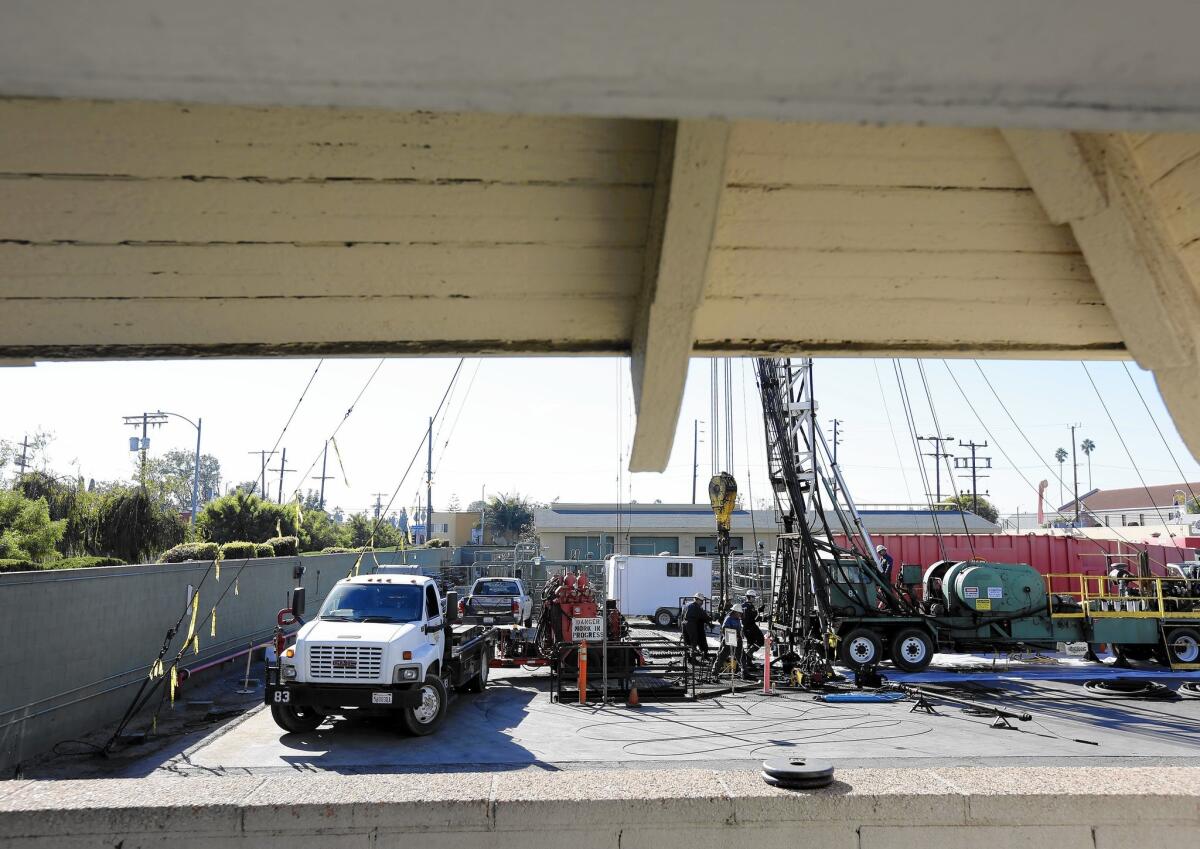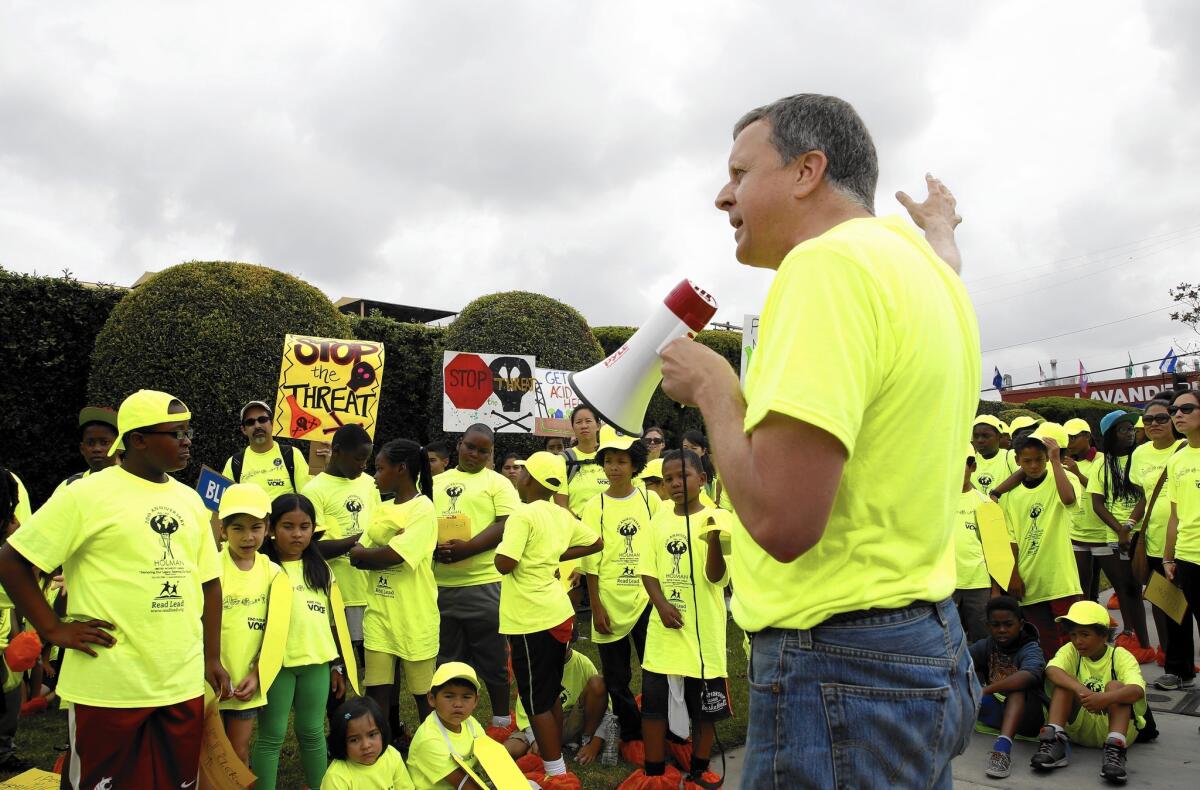South L.A. residents want city to act on Jefferson Boulevard oil drilling site

- Share via
At a packed hearing at City Hall more than a year ago, South Los Angeles residents argued that oil drilling had caused foul smells, thunderous noise and other nuisances in their neighborhood west of USC.
They urged the city to examine whether the oil company had been violating decades-old city rules before allowing additional drilling on the Jefferson Boulevard site. And they pushed for the city to impose stricter conditions to protect neighbors, including enclosing the drilling equipment in a building, as oil producers have done elsewhere in the city.
Residents say they are still waiting for the city to take action. “How does the Planning Department hear all these health and safety concerns — and then just walk away as if it never happened?” asked Richard Parks, president of the nonprofit Redeemer Community Partnership.
The company now running the Jefferson Boulevard site, Freeport-McMoRan, disputed their nuisance claims. It ultimately withdrew its plans to drill one well and redrill two others, but neighborhood activists said that even if nothing new was planned, they still wanted the city to examine whether the company had been following the rules.
The demand for action at the Jefferson Boulevard site is part of a growing push for the city to step up its oversight of oil drilling.
Roughly 1,000 active oil and gas wells are scattered across the city, many near homes and schools. As L.A. politicians demand action to protect Porter Ranch residents displaced by a natural gas leak just north of the city, on county land, environmental and neighborhood activists are pressing them to reexamine their own power over oil and gas facilities within city limits.
Youth and environmental groups recently sued the city, arguing that the Planning Department had been improperly “rubber-stamping” drilling applications and had required fewer protections for neighbors around drilling sites in predominantly black and Latino neighborhoods than those in white areas.
The lawsuit singled out the Jefferson site as an example. The facility, which sits next to apartments in a largely Latino and black stretch of South Los Angeles, is closer to homes and other “sensitive sites” than any other L.A. drilling facility, according to the nonprofit Community Health Councils.
In their letter to the city last year, community groups said they wanted an annual review of city conditions on the drilling site, the installation of air and noise pollution monitoring equipment that operates around the clock, and other changes to protect neighbors.
Industry groups have been skeptical of the push for city action, stressing that a number of state, county and regional agencies also regulate drilling. Sabrina Lockhart, a spokeswoman for the California Independent Petroleum Assn., said that calls to reexamine city rules for the Jefferson site were “veiled attempts to stop operations that will hurt the local community through job loss and reduced revenue and royalty benefits.”
The Planning Department, which has been the focus of the criticism, has downplayed its role in overseeing drilling. Department head Michael LoGrande declined to answer questions about the Jefferson site because the facility is mentioned in the recent suit against the city.
But at a Planning Commission meeting in October, LoGrande said that enforcement of any kind of site-by-site conditions is generally handled by another city department — Building and Safety — and that enforcing any conditions tied to oil drilling is “more of a state issue.”
Environmental and community activists counter that the city has a unique and broad role compared with other agencies that regulate specific aspects of oil production, such as air quality.
The city “is the one that fundamentally allows that facility to exist where it exists,” said Angela Johnson Meszaros, a staff attorney with the nonprofit law firm Earthjustice.
Johnson Meszaros and community activists point to the Los Angeles Municipal Code, which says the city can change or revoke approvals by the Planning Department for a number of reasons, including if the resulting activity jeopardizes the health or safety of neighbors, creates a public nuisance or violates local, state or federal law.
But city codes do not spell out how severe the problems must be to trigger action. Ed Renwick, an attorney who represents oil producers and royalty owners, said the city used to have “a highly skilled, knowledgeable, well-respected-by-all-parties petroleum administrator” to help weigh such claims, but it no longer has an expert filling that role full time.
That puts the Planning Department in a tough position because it could also be sued for interfering with the rights of the oil company, Renwick said.
See more of our top stories on Facebook >>
As drilling expanded across the city decades ago, Los Angeles set out site-by-site rules to protect neighbors. But city officials say L.A. has no system to proactively and regularly check whether oil companies are hewing to city conditions. Instead, it responds to complaints.
For instance, at the AllenCo Energy Inc. drilling site on 23rd Street, neighbors said they endured headaches and nosebleeds for years. After environmental officials investigating noxious odors fell ill while visiting the site, the company suspended operations. City Atty. Mike Feuer sued to prevent AllenCo from reopening the site, saying it had created a public nuisance.
But amid the uproar, the city did not scrutinize whether AllenCo was following a long list of requirements that officials had imposed before allowing drilling at the South L.A. facility.
In the AllenCo case, neighbors took their complaints to the South Coast Air Quality Management District — not to the city — which was one reason why L.A. officials didn’t immediately get involved. At the Jefferson site, residents complain that they have gone to the city Planning Department, yet still not spurred action.
In addition, environmental activists complain that rather than strengthening protections at the Jefferson site, L.A. has weakened them.
When the Jefferson site was first approved in 1965, the city insisted that the company operating it should hang on to neighboring buildings as a “buffer.” But city officials altered that rule in 1999, allowing then-empty buildings to be sold off and used as housing. When they were sold, the deed stated that oil operations next door could cause noxious fumes, loud noise and safety hazards.

Across the street from the drilling site, Edna Roberts says noise routinely sends her to the back of her South Los Angeles apartment. “It’s noisy and dusty,” Roberts, 92, said one summer afternoon last year, gesturing at the yellow walls of the facility visible from her front porch. “You can dust 50 times and it doesn’t do anything.”
More than four years ago, oil droplets drifted from the drilling site onto one of the neighboring buildings — an episode Parks and other activists say shows L.A. should have never allowed them to be occupied. In a letter, they said Freeport-McMoRan should be required to relocate tenants out of the “buffer” buildings.
Freeport-McMoRan spokesman Eric Kinneberg said the buildings had already been rented out to tenants years before the change in the conditions, though he was unable to provide documentation to show that. He said the city had designated the building as a buffer “to require disclosure to prospective occupants that the buildings were located next to a facility with 24-hour continuous operations.”
The company has argued against changing the conditions imposed on the site, contending that any problems there have not risen to the level of a health or safety threat.
South Coast Air Quality Management District records show that the Jefferson site had two violation notices in the last two years for excessive emissions from a unit that treats water, which the company characterized as minor. The facility has not had any violations from the state Division of Oil, Gas, and Geothermal Resources for a decade, according to state records.
And the company said it hadn’t been cited for noise violations since it acquired the facility. Freeport-McMoRan told the Planning Department it had fixed sidewalks, replaced missing bricks and repainted building eaves to address community concerns. And it stressed that the site generated more than $2 million annually in royalties.
The push for a review, it said in a letter to the city, was “simply a harassment tactic.”
Residents have pointed out that the Municipal Code states that a planning official — the chief zoning administrator — has the power to impose added conditions on urban drilling sites if needed to protect neighbors. So do the rules specifically imposed on the Jefferson Boulevard site.
“Your hands are not tied,” West Adams resident Michael Salman wrote in a letter to the planning official who handled the recent Jefferson case, arguing that the Planning Department had both the power and responsibility to impose added conditions to protect neighbors. “In fact, the opposite is true.”
City Councilman Marqueece Harris-Dawson, who represents the area around the drilling site, said he believes it is time for L.A. to reexamine the city requirements there.
“The Planning Department should take a hard look,” he said.
Twitter: @LATimesEmily
ALSO
Extradition of suspect in killing of 2 Arcadia teens could be complicated
Female pilots who earned wings on home front seek place in Arlington
Search continues for inmates who escaped from Orange County jail
More to Read
Sign up for Essential California
The most important California stories and recommendations in your inbox every morning.
You may occasionally receive promotional content from the Los Angeles Times.














